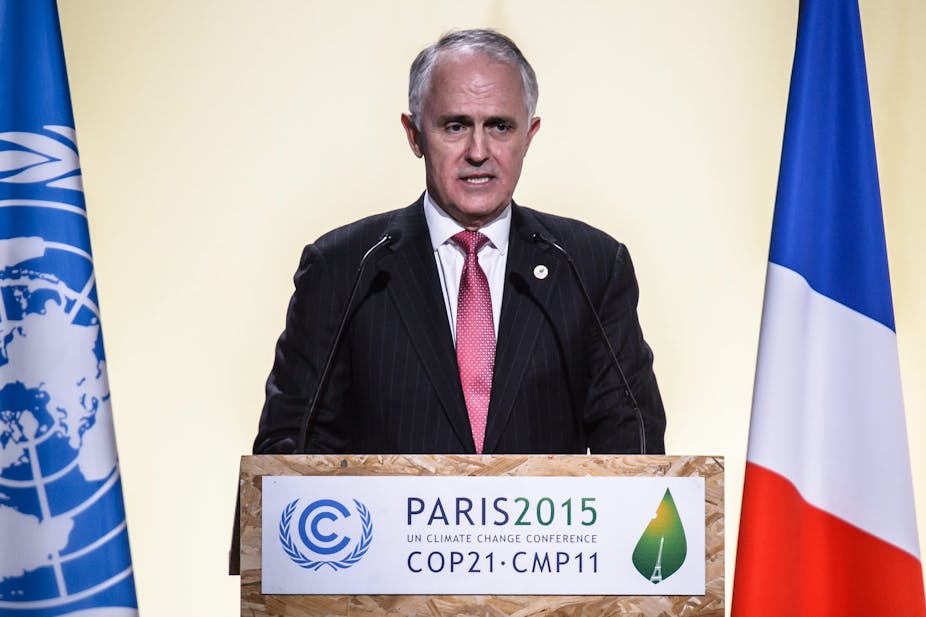Prime Minister Malcolm Turnbull’s pledge overnight in Paris that Australia will ratify the second phase of the Kyoto Protocol is welcome news.
The first phase of the Kyoto Protocol commenced in 2008 and concluded in 2012. In November 2007, in his first act as prime minister, Kevin Rudd ratified this phase, committing Australia to an emissions target to limit greenhouse gas emissions to 8% above 1990 levels over the 2008-2012 period.
The second phase of the Kyoto Protocol covers the period 2013 to 2020. This was agreed to by the parties to the Kyoto Protocol, including Australia, at the United Nations climate talks in Doha in 2012.
Turnbull’s pledge commits Australia to a 5% reduction in greenhouse gas emissions below 2000 levels in the second phase.
Presently, 54 countries have submitted their instruments of acceptance to the second commitment phase of the Kyoto Protocol. To enter into force however, three quarters of the nations to the Protocol will have to submit, which means 144 nations out of 192.
Australia’s pledge to ratify the second phase may encourage other countries to do the same. Alternatively, Australia’s low 2020 target, which some say is out-of-step with the rest of the world and the science of climate change, may simply further frustrate some developing countries. These countries are already very concerned that industrialised counties are continuing to side-step their leadership obligations under the existing UN climate regime.
Turnbull’s pledge comes as Australia’s new prime minister seeks to distinguish his government from his predecessor on this issue. This new tack is also consistent with Turnbull’s new positive message about opportunities and innovation, and with his previous position on climate as opposition leader in 2009.
This step means that the Turnbull government is locked into an emissions reduction target, but not the method of how to achieve it.
Not a done deal
Ultimately, Australia’s international policy position on climate change is determined by domestic politics.
In Australia’s political system ratifying international treaties, which includes the Kyoto Protocol Mark I and II, does not require any formal legislative approval. The final decision rests at a ministerial level, and ultimately the prime minister, with a keen eye to the mood of the party room.
Environment minister Greg Hunt said this morning that “Australia will ratify Kyoto II with the support of the cabinet and party room”. So it seems that this base is covered, for now. Indeed some in the Liberal party room are already warning against target increases.
The parliamentary oversight that does exist for treaties, for instance the Joint Standing Committee on Treaties, is relatively weak, usually acting as a rubber stamp. So this aspect seems to be covered.
If Australia does ratify the second phase of the Kyoto Protocol, it is entirely possible that sometime between now and 2020 we will see a switch to an emissions trading scheme (ETS), which would of course require the passage of a new bill through both houses of parliament.
The Climate Change Authority’s second draft report of Australian climate policy released yesterday required the authority to consider whether an ETS would harm Australia’s international competitiveness. This may mean designing an ETS that allows liable polluting firms to import an unlimited number of cheap international carbon credits to meet their emissions caps, reducing the incentive to clean up domestic production processes. We saw this previously under the Rudd-Turnbull Carbon Pollution Reduction Scheme.
Other domestic constraints over national climate policies and Australia’s international negotiating positions may emerge externally from the Parliament, for example, from Australia’s fossil fuel lobby. However, public opinion, which is squarely behind strong action on climate change, may enable the government to propose stronger targets.
Obstacles abound before we get a clear picture of Australian climate policy moving forward.

